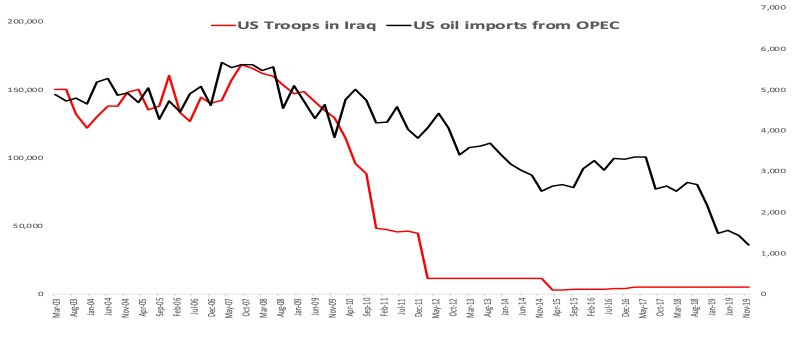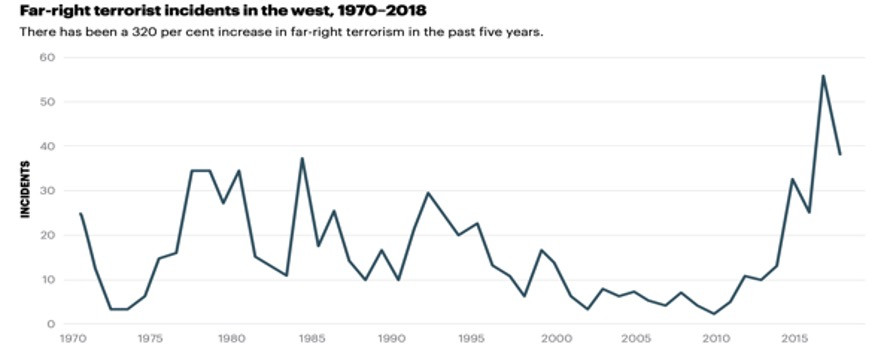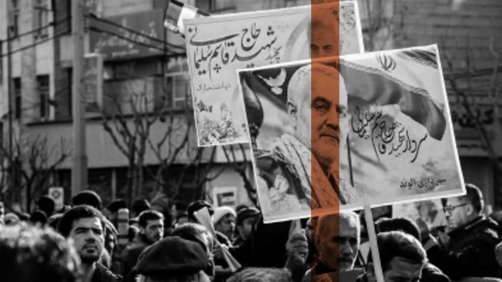One of our favorite quotes is from the poet Jalal-ud-Din Rumi, who said: “All your anxiety is because of your desire for harmony. Seek disharmony; then you will gain peace.”
President Trump did his part to create disharmony on January 3, when he authorized a drone strike at a convoy near Baghdad airport to assassinate Qasim Suleimani, Iran’s most powerful military commander. Suleimani led the Revolutionary Guards’ elite Quds Force and helped direct wars in Iraq, Syria, Lebanon and Yemen. He was the second-most revered person in Iran after the Supreme Leader, Ayatollah Ali Khamenei.
“The US just killed Iran’s Patton,” Ian Bremmer, the head of the Eurasia Group, tweeted as the news broke out. This is America’s “boldest move in confronting Iran since the 1972 revolution,” wrote foreign affairs analyst Robin Wright in The New Yorker, tantamount to “an act of war.” Award-winning Middle East correspondent Robert Fisk described the US strike as “a sword at the heart of Iran.” This has unleashed fears of war and a new cycle of endless violence.
British Prime Minister Boris Johnson, German Chancellor Angela Merkel and French President Emmanuel Macron have called for “utmost restraint” and said there is now an “urgent need for de-escalation.” Even Pope Francis issued an appeal for peace and calm amid what he said is an “air of tension.” throughout the world. Alongside Suleimani’s name, phrases such as Franz Ferdinand and World War III have been trending.
We are not unnerved. The Iranians will no more go to war with America than America will go to war with Iran. Counter to popular perceptions, a sober reading of the situation portends that Suleimani’s assassination is, in fact, the best chance for peace in the Middle East.
First, some background.
America’s Energy Spring
As America has transitioned from energy dependence to dominance, the Middle East no longer ranks high in the hierarchy of national interests. US oil imports from OPEC countries are down 80 percent since 2007, as shale output has helped US oil production cross 13 million bpd. The number of American troops in Iraq have declined by 96 percent, from 166,300 in October 2007 to a mere 6,000 today. There is nothing left for the US to do in Iraq or the Middle East.
President Trump reiterated this conclusion last week, saying, “Let someone else fight over this long blood-stained sand. Going into the Middle East was the worst decision ever made in the history of our country.” The costs of Middle East wars since 2001 have totaled more than $5.6 trillion.

Source: Bloomberg
On January 5, the Iraqi Parliament voted to expel American troops from the country. President Trump said that he wants to get out, but “this isn’t the right point.” He added that he would only withdraw troops if Iraq paid for building and maintaining the air base there. We believe that Trump will use American forces in Iraq as negotiating leverage against Iran. He will pull the remaining troops out of Iraq after extracting concessions, which will placate Iran.
We do not expect a major terrorist comeback from the remnants of ISIS, even after the US withdraws from Iraq. ISIS ravaged Iraq starting in 2014 but it was Iran, along with Russian air power and Kurdish forces, that dealt the decisive blows and helped reclaim Iraqi territory. Suleimani was an indispensable figure in the fight against ISIS, which was almost entirely crushed in 2018.
The world is more peaceful today. Total deaths from terrorism are down over 52 percent from their peak in 2014. There were no attacks by a known terrorist group in the US in the last couple of years. There is more concern now over the threat posed by far-right extremism and mass shootings than religious terrorism. Far-right terrorist attacks in the West have more than tripled in the past five years.

Source: Global Terrorism Index 2019
Wag the dog
Both President Obama and President Bush both passed on killing Suleimani fearing retaliation and the potential of being pulled into a more protracted conflict. That may have been the right decision at the time, as America was fighting on multiple fronts in the Middle East and losing, while terrorists were also striking in Western cities. Even if Trump’s decision was inspired to distract from the impeachment proceedings at home, the opportunity to kill Suleimani was asymmetric and “low risk” in our view. America has geopolitically deleveraged from the region and Trump’s maximum-pressure campaign has squeezed Iran into a weakened state.
The International Monetary Fund projects Iran’s gross domestic product will decline by 9.5 percent in 2020, following a 4.8 percent contraction in 2019. Inflation is running above 40 percent and the Iranian state coffers are empty. Iran’s oil exports have fallen from 2.1 million bpd in 2016 to less than 300,000 bpd today.
Before January 3, Iran was experiencing widespread demonstrations to protest the surge in fuel prices and the corrupt, theocratic regime’s failure to deliver jobs and prosperity. Unemployment remains high, at 12 percent, and is especially prevalent among young people. Sources suggest security forces have killed at least several hundred protesters in a brutal crackdown and arrested up to 7,000. This is the deadliest political unrest since the Islamic Revolution 40 years ago.
Iran’s constraints
Iran announced that it would no longer abide by the 2015 agreement to limit the number of centrifuges used to enrich uranium, the fuel to make a nuclear weapon. However, Tehran said that it would continue to cooperate with the International Atomic Energy Agency, the UN nuclear watchdog that closely monitors aspects of Iran’s nuclear program. European leaders said during an emergency session on January 10 that they are willing to maintain the Iran deal as long as Tehran fulfills its commitments in order to achieve it. The corollary is there is no danger here: an Iranian nuclear bomb is not a fait accompli. The truth is this is Iran’s only negotiating leverage.
Tehran wants to expel all US forces from the Middle East. That is not going to happen. There are more than 50,000 American troops stationed in military bases across the Gulf monarchies of Saudi Arabia, the United Arab Emirates (UAE), Bahrain, Kuwait and Qatar. While these are within easy reach of Iran’s huge missile arsenal, this would guarantee self-destruction. Tehran has said it will not retaliate against its Arab neighbors. We think Tehran will instead pressure neighboring countries to stop the inward flow of more US troops and halt purchases of US weapons. Defense stocks have predictably rallied since the killing of Suleimani, but we are bearish on the sector.
After vowing “severe revenge” that would be a “historic nightmare,” Iran launched a dozen ballistic missiles on two Iraqi military bases housing US troops on January 8, which killed nobody. This was deliberate. Iran tipped off Iraqi officials, who gave advance warning to the Americans. The Iranian media, though, claimed that as many as eighty Americans had been killed. Iran’s state-controlled television commented that, “Suleimani’s revenge was taken and now he can rest in peace.” Iranian foreign minister, Javad Zarif, said Iran has “concluded proportionate measures” in retaliation and “we do not seek escalation or war.”
Contrary to what is solemnly believed by many Western analysts, Iran is a rational political actor and will not seek to avenge Suleimani’s death by doing something that is irresponsible. That would turn the world, in particular the Europeans, against it. Their booming investment in Iran’s energy sector is of vital importance.
As it is, Iran is facing international pressure and domestic blowback after admitting to “accidentally” shooting down a Ukrainian passenger jet, which took 176 lives including 82 Iranians. This follows the death of 56 mourners who were crushed during Suleimani’s funeral processions. People in Tehran are once again taking to the streets and chanting slogans to denounce the Revolutionary Guard and the Supreme Leader.
Order from chaos
Just as the journalist Jamal Khashoggi’s brutal killing in Saudi Arabia’s Istanbul consulate in October 2018 put the Saudis on the defensive and forced them to pragmatically reexamine their regional policies, so will this tragedy do for the Iranians. Make no mistake—this is a significant, constructive turning point in Middle East politics.
Suleimani was the architect of Iran’s intelligence and military operations abroad, spearheading a three-decade project to build a Shiite sphere of influence, stretching from Lebanon to Yemen. His death will substantively affect Iran’s regional operations. Iran is already facing backlash in Iraq and Lebanon. Esmail Ghaani, the general announced as his successor, didn’t deal with Iraq, Syria or Yemen intimately and doesn’t have the same power, prestige, and reach as Suleimani. He will take time to catch up. That opens a window of opportunity for peace-making.
Saudi Arabia has long pushed for a tougher American stance against Iran. But now Crown Prince Mohammed bin Salman is urging restraint. He sent his younger brother, vice minister of defense Khalid bin Salman, to meet with President Trump with an appeal for calm. The reason for this new sensibility is that after years of growing hostility and competition for influence, Saudi Arabia and Iran are finally taking steps to end conflict and find some new equilibrium. Those steps will continue despite the US attack. Suleimani had, in fact, arrived in Baghdad to coordinate talks with the Saudis. An Iranian-Saudi dialogue, as discussed in our November issue, could help solve many of the region’s security and political problems. Saudi Arabia is hosting the G20 meeting in Riyadh at the end of this year.
Qatar’s foreign minister, Mohammed Al Thani, met with Iranian president Hassan Rouhani to discuss “measures to maintain the security and stability of the region”; Adel al-Jubeir, the Saudi minister for foreign affairs, called for the importance of self-restraint to “save the countries of the region and their people;” and the UAE’s foreign minister, Anwar Gargash, beseeched “rational engagement,” tweeting: “wisdom and balance must prevail.” The surprising, unintended consequence of Suleimani’s assassination is that it is bringing Gulf countries closer to Iran, creating the best chance for peace in the region.
Brink of peace
Eventually, Iran and the US will return to the negotiating table, though we are less sure if this happens before or after the presidential election. The strategic American rationale for the 2015 Iran nuclear deal has not changed.
Washington’s core interest in the Middle East today—aside from a lucrative market for weapons exports—is limited to the safe and secure passage of oil. The closure of the Straits of Hormuz, through which 30% of all seaborne-traded oil (or approximately 17 million bpd) flows, could create the largest oil supply disruption in history. This would hurt the global economy, and consequently the US. As Iran is the only country with sufficient naval power to ostensibly threaten the Strait, America acquiesced to Tehran becoming a nuclear-capable power in exchange for a compliant Iranian foreign policy. Given Iran’s beleaguered oil industry would be able to attract much-needed foreign investment, and its rising oil output would flow back to the global market, there would be no reason to close the only transit route.
This suggests there is potential for a deal in which Iran resumes compliance with the nuclear agreement, halts its proxy warfare in the region, and agrees to start negotiations on a more comprehensive agreement in exchange for the US relaxing sanctions. French President Emmanuel Macron asserts that leaders in the US and Iran had accepted these principles before negotiations broke down recently because Trump demanded he first meet with Rouhani before lifting any sanctions, and Iran insisted that sanctions be lifted first. This is hardly insurmountable.
War with Iran is widely unpopular in America and won’t help Trump win reelection. The president himself said from his Mar-a-Lago resort as he announced the attack: “We took action last night to stop a war. We did not take action to start a war.” Days later, speaking to the nation, Trump said that America wants Iran to have a “great future, one that you deserve—one of prosperity at home and harmony with the nations of the world. The United States is ready to embrace peace with all who seek it.”
It is worth remembering that the toppling of Saddam Hussein’s statue in Baghdad shortly after the invasion of Iraq in 2003 and the civilian uprisings in 2011, dubbed Arab Spring, were celebrated and covered by the media as a historic achievement for several months. In reality, both events led to a disaster of epic proportions. The Iraq war claimed over a million lives and the Arab Spring revolutions led to the worst global refugee crisis in history.
Today, we believe the opposite is happening. Global media is echoing warnings of mayhem and blood-curling destruction after Trump’s Iran strike. In truth, we are moving toward the brink of peace.

Photo: Associated Press






